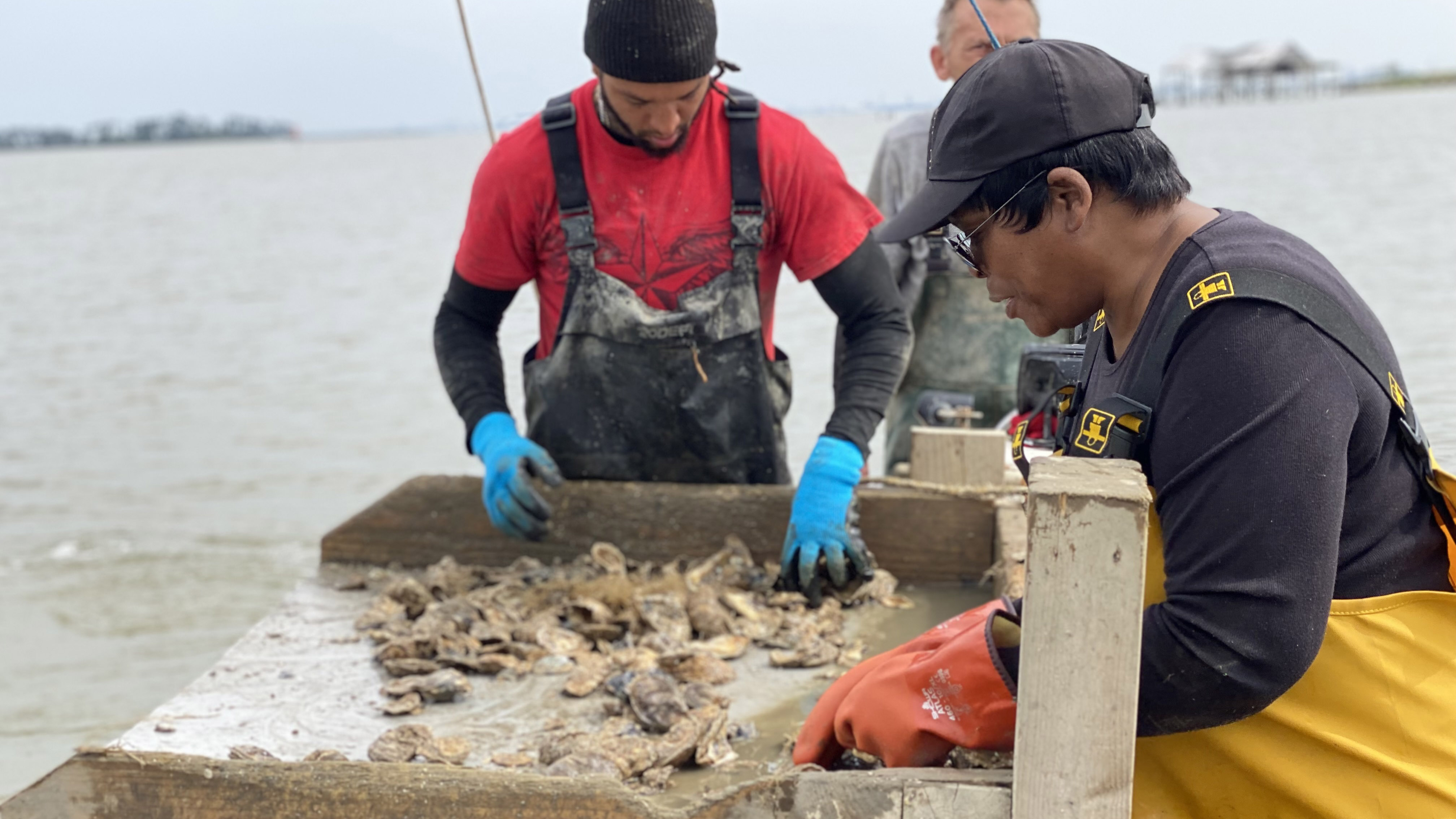
Editor's note: This story is part of an NPR project documenting historical markers throughout the United States. Read more here.
On a warm spring morning, Mary Hill is on a boat working her oyster grounds just north of the Crittenden Bridge in Chuckatuck Creek.
“I’ve got about 500 acres out here,” she says, pointing to markers dotting the creek, which feeds into the Nansemond River.
Thousands of oysters in buckets already line the boat’s perimeter while Hill and two colleagues lower a dredge into the water.
The metal cage scrapes the bottom of the oyster beds. The crew raise it up, dump the bounty and start sifting through oyster shells, tossing small ones back into the water to replenish the reefs.
To Hill, these mornings out on the water are more than just a job. It’s her family legacy.
“This is seven generations of oyster grounds,” she says. “So these oysters (have) been sitting here waiting for me.”

Mary Hill and colleagues lift an oyster dredge from Chuckatuck Creek in Suffolk.
Hill is descended from enslaved Virginians who found freedom harvesting oysters in what’s now Suffolk.
These Black oystermen created their own, flourishing economy in the village of Hobson. It thrived for a century before pollution devastated the industry.
Now, Hill fears Hobson’s cultural history – and future – are in jeopardy.
The only remaining physical sign of the community’s history is a highway marker put up in 2005, denoting Hobson as “an example of an African American oystering village” in the Chesapeake Bay watershed.
Hill helped get the marker, which sits across from her house. It’s part of her ongoing fight to keep the village’s legacy alive on and off the water.
“We don’t want to be just some people you read about in a history book,” she said. “We want this to remain a thriving village for future generations. And that’s my calling – that’s the thing I have to never be willing to give up.”

Mary Hill stands next to Hobson's highway historical marker in Suffolk.
“A pathway to our freedom”
Hobson’s official founders were among many enslaved people who escaped their legal owners throughout Hampton Roads during the Civil War.
They sought refuge behind Union Army lines on Fort Monroe and in Yorktown and Williamsburg, said Tommy Bogger, a retired longtime professor and archivist at Norfolk State University who has extensively researched Hobson’s history.
After the war, thousands of Black people were living in refugee encampments on the Peninsula and white officials felt threatened by them, turning to violence to break up the groups, Bogger said.
Many of the freed Blacks fled, including a small group that left James City County in 1865 and ended up in the Barrett’s Neck area of what was then Nansemond County.
There, 16 families joined what became the village of Hobson, named by the U.S. Postal Service after a Spanish-American war hero.
Some of them probably escaped from Barrett’s Neck before slavery fell, “and now they were willing to go back home,” Bogger said.
They brought with them oystering skills they’d likely picked up before and during slavery to help feed their families.
Sandwiched between the Nansemond River and Chuckatuck Creek, Hobson was conveniently located for waterfront industry.
At the time, oysters weren't as popular with white Virginians, Bogger said. Virginia’s legislature even passed a law in the late 1860s imposing a tax on the oyster industry, knowing most of its workers were African Americans selling them to “Yankees up north.”
During the oyster offseason, some of Hobson’s watermen worked on local white-owned farms to supplement income.
Soon, they had saved enough for their own land. A majority of Hobson heads of household became landowners by the 1900s, Bogger said – a rare situation for rural Black Virginians.
Hill grew up in one of the original houses, surrounded by plenty of land where her family farmed, planted fruit trees and helped build a church.
She was born in 1960 and recalls the Hobson of her childhood as tight-knit and self-sufficient.
“We had everything we needed” within a few blocks’ radius, she said – teachers, preachers, seamstresses, and so on.
During oyster season in the wintertime, just about everyone was involved. The men worked out on the water, but women often worked in shucking houses on shore, which could be painstaking work.
Hill recalls plucking icicles off her father’s head when he came home from work.
But they didn’t complain.
“It provided food, clothing and shelter for their families and nothing would keep them from working the river,” Hill said.
Life revolved around the water. Hill and many others were baptized in the Nansemond River, which they saw as a spiritual connector.
Oystering “became our livelihood,” Hill said. “But foremost, it was a pathway to our freedom.”

Documents pertaining to Hobson's history at Mary Hill's home in Suffolk.
The demise of oystering in Hobson
Things took a turn in the late 1960s and ’70s.
First, the Army Corps of Engineers built a dam across a local creek that cut off Hobson residents’ direct access to their oyster beds. Watermen would have to find new places to dock and launch their working boats, including paying marina fees where they’d previously kept boats at home.
This “struck a devastating blow to the economic well-being of the community,” according to Hobson’s listing on the National Register of Historic Places, which Hill and Bogger helped write.
No one consulted or warned residents about the dam.

Mary Hill looks over a dam built across Carter's Cove Creek in 1968, which cut off residents' access to their oyster grounds.
Around the same time, the water itself became toxic. Local waterways were already battling parasitic diseases killing oysters.
Then came the infamous Kepone disaster. For several years, industrial plants in the Hopewell area dumped a toxic chemical called Kepone into the James River, polluting the whole watershed and shutting down fishing operations.
Most of Hobson’s oystermen had to close up shop.
“When the Kepone came and devastated our industry, they had no legacy to leave to us,” Hill said.
People had to look outside the village for work, including many who were hired at local shipyards.
Hill was one of those who left, for a time. She returned to Hobson about 25 years ago to care for her aging mother, Marie Hill. (Marie, a fixture in the community, died last year at 102 and was honored by the General Assembly for her “profound and lasting impact.”)
Hill got interested in local history and teamed up with Bogger to collect oral histories from elders in the community, who emphasized the importance of preserving Hobson’s history and culture.
They've gathered evidence from things like gravestones that some ancestors settled in the area even before the Civil War. Hill's great-great-grandfather's home was built in 1754, for example, according to Suffolk real estate records. She hopes to eventually correct Virginia's official records of Hobson to reflect that.
About a decade ago, Hill was also inspired to get back out on the water.
It was a struggle, particularly as a Black woman, to be accepted into the modern oystering world, Hill said. But she now runs Barrett’s Neck Seafood, selling oysters to a Gloucester-based distributor.
It’s all possible because Hobson residents refused to ever give up their oyster grounds. That meant paying taxes on the oyster beds every year, even when they weren’t yielding any revenue.
“They believed that those oysters would come back one day, for survival,” Hill said. “And it is back.”

Mary Hill stands next to a picture with her mother, Marie Hill, who died last year at 102 and was honored by Virginia's legislature.
Keeping history alive
Last year, Preservation Virginia named historic resources associated with African American watermen as some of the Commonwealth’s most endangered historic places.
Structures around the Chesapeake Bay like oyster shucking houses, marinas and community buildings “are disappearing as sea levels rise and new development occurs,” the preservation group wrote.
Some efforts are underway to change that before it’s too late, including an African American Watermen Project that aims to document 100 related historic resources in Virginia.
Hill said she’s witnessing Hobson’s resources fade away in real time.
Back in 2011, city officials razed a historic building just across from Hill’s house, a former Masonic Lodge that was a community gathering place and at one point a school.
Hill and another community activist protested by standing inside the lodge when wrecking crews arrived. They were arrested and charged with trespassing, and the building was demolished.
Today, Hobson is a neighborhood in transition. Older brick homes or empty properties are the vestiges of Hill’s childhood – and many are still owned by her family. But larger, modern and more expensive homes are going up in between.
The newer homes – built on higher ground because of sea level rise – also contribute to ongoing drainage and flooding issues in the area, another of Hill’s battles.
For decades, the city of Suffolk denied services to Hobson that it provided for other, white neighborhoods, Bogger said.
The community had to pay to bus their children to the nearest school after desegregation. They also built their own well system and used oyster shells to fill in potholes.
Now, Bogger said the city should play a role in protecting and revitalizing the neighborhood.
“Don't wait ’til they’ve moved on from the community and then replace them with million dollar homes and get them all these things that the people in Hobson didn't get,” he said.
“It’s never too late to do them justice.”
Editor's note: This story has been updated to reflect residents' research and oral histories of Hobson's roots stretching back to before the Civil War.

Mary Hill sifts through oysters from her grounds in Chuckatuck Creek.


